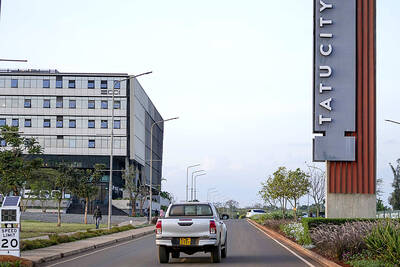DRAM chipmaker Nanya Technology Corp (南亞科技) yesterday posted its weakest monthly revenue in five months after prices dropped 2.6 percent sequentially amid widespread weakness in the chip industry.
Revenue contracted 1.48 percent to NT$4.09 billion (US$131 million) last month, compared with NT$4.15 billion in October, according to a company statement. Last month’s figure is the lowest since June after declining for a third month.
Shipments were little changed from October, the chipmaker said.
On an annual basis, revenue grew 10.7 percent from NT$3.7 billion last year.
The Taoyuan-based chipmaker in October said that the blended average selling price would fall by 3 to 5 percent sequentially this quarter because of sluggish demand for chips used in consumer electronics, such as set-top boxes, while shipments would remain flat.
Separately, Inotera Memories Inc (華亞科技), a DRAM joint venture between Nanya and US memory chipmaker Micron Technology Inc, said revenue fell 1.9 percent to NT$6.59 billion last month.
That represented 2 percent annual growth from NT$6.45 billion.
The revenue decline was also seen in other chip companies.
Advanced Semiconductor Engineering Inc (ASE, 日月光半導體), the world’s top chip tester and packager, said revenue shrank 4.8 percent to NT$25.25 billion last month from October’s NT$26.52 billion.
Compared with NT$21.97 billion last year, last month’s revenues expanded 14.9 percent.
ASE is expected to post 12 percent sequential growth in consolidated revenue, mostly fueled by a 3 percent quarterly increase from its system-in-package business.
Macronix International Co (旺宏電子), which counts Japanese video game console maker Nintendo as one of its major clients, said revenue plunged 20.4 percent to NT$1.9 billion last month from NT$2.39 billion a month ago. That translated to a year-on-year decline of 0.1 percent from NT$1.9 billion.

To many, Tatu City on the outskirts of Nairobi looks like a success. The first city entirely built by a private company to be operational in east Africa, with about 25,000 people living and working there, it accounts for about two-thirds of all foreign investment in Kenya. Its low-tax status has attracted more than 100 businesses including Heineken, coffee brand Dormans, and the biggest call-center and cold-chain transport firms in the region. However, to some local politicians, Tatu City has looked more like a target for extortion. A parade of governors have demanded land worth millions of dollars in exchange

An Indonesian animated movie is smashing regional box office records and could be set for wider success as it prepares to open beyond the Southeast Asian archipelago’s silver screens. Jumbo — a film based on the adventures of main character, Don, a large orphaned Indonesian boy facing bullying at school — last month became the highest-grossing Southeast Asian animated film, raking in more than US$8 million. Released at the end of March to coincide with the Eid holidays after the Islamic fasting month of Ramadan, the movie has hit 8 million ticket sales, the third-highest in Indonesian cinema history, Film

Taiwan Semiconductor Manufacturing Co’s (TSMC, 台積電) revenue jumped 48 percent last month, underscoring how electronics firms scrambled to acquire essential components before global tariffs took effect. The main chipmaker for Apple Inc and Nvidia Corp reported monthly sales of NT$349.6 billion (US$11.6 billion). That compares with the average analysts’ estimate for a 38 percent rise in second-quarter revenue. US President Donald Trump’s trade war is prompting economists to retool GDP forecasts worldwide, casting doubt over the outlook for everything from iPhone demand to computing and datacenter construction. However, TSMC — a barometer for global tech spending given its central role in the

Alchip Technologies Ltd (世芯), an application-specific integrated circuit (ASIC) designer specializing in server chips, expects revenue to decline this year due to sagging demand for 5-nanometer artificial intelligence (AI) chips from a North America-based major customer, a company executive said yesterday. That would be the first contraction in revenue for Alchip as it has been enjoying strong revenue growth over the past few years, benefiting from cloud-service providers’ moves to reduce dependence on Nvidia Corp’s expensive AI chips by building their own AI accelerator by outsourcing chip design. The 5-nanometer chip was supposed to be a new growth engine as the lifecycle